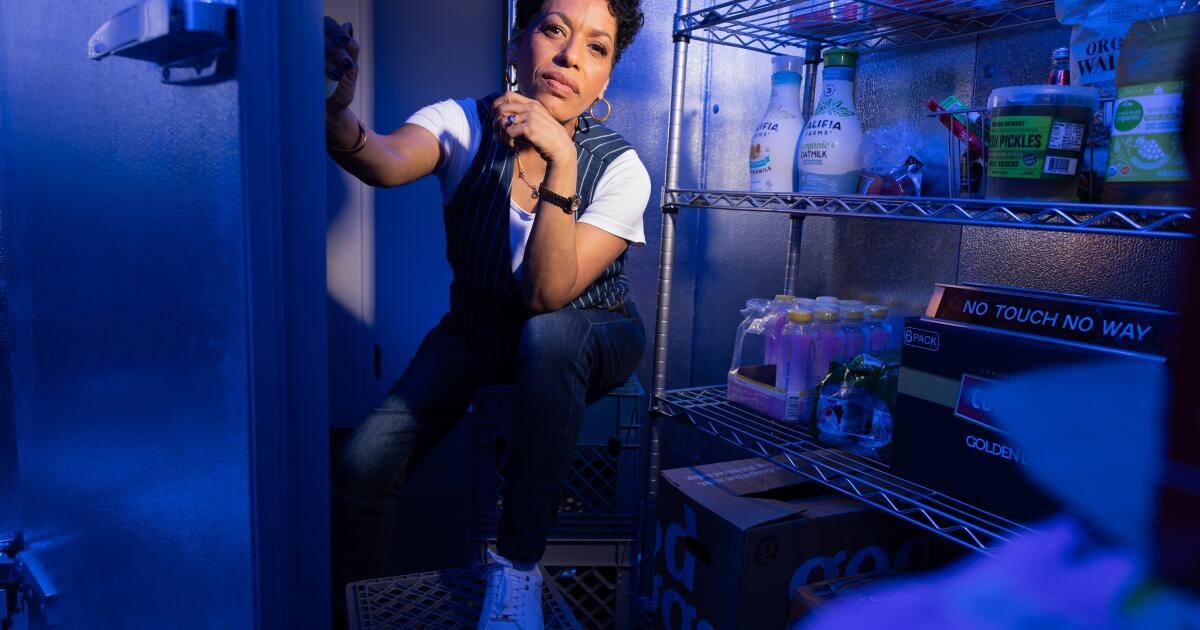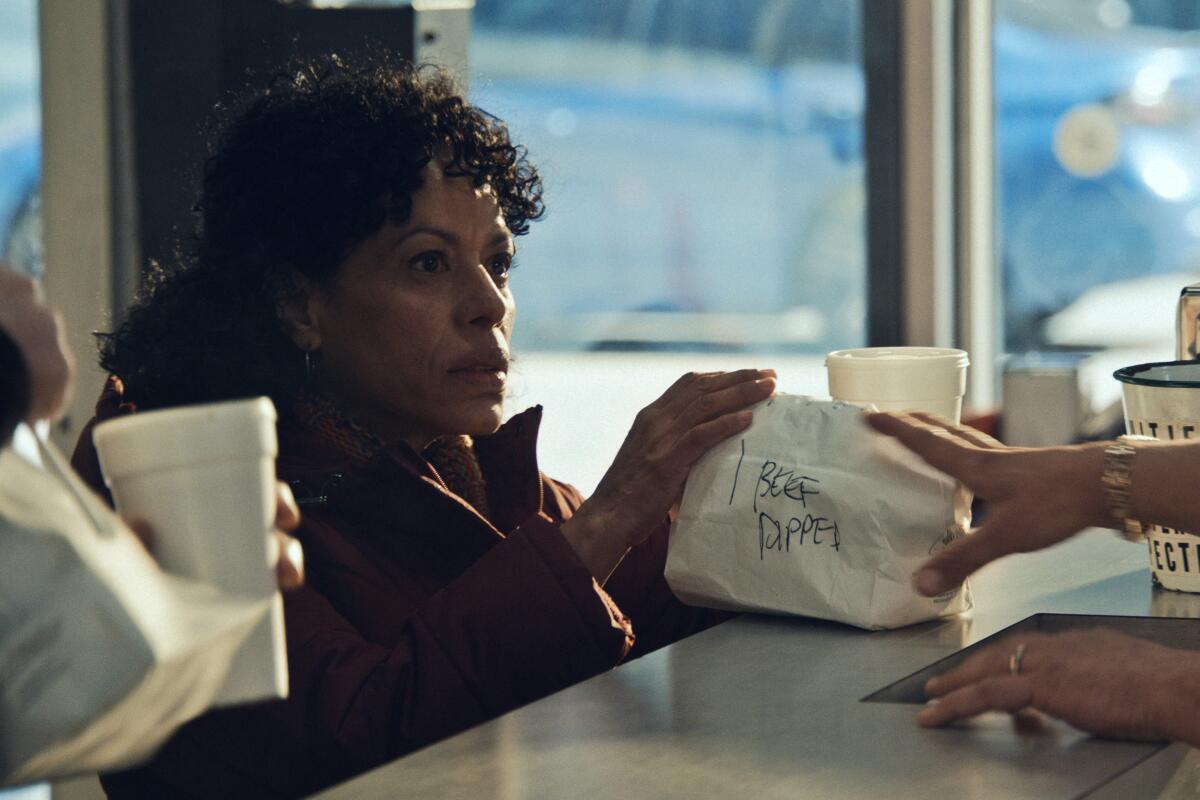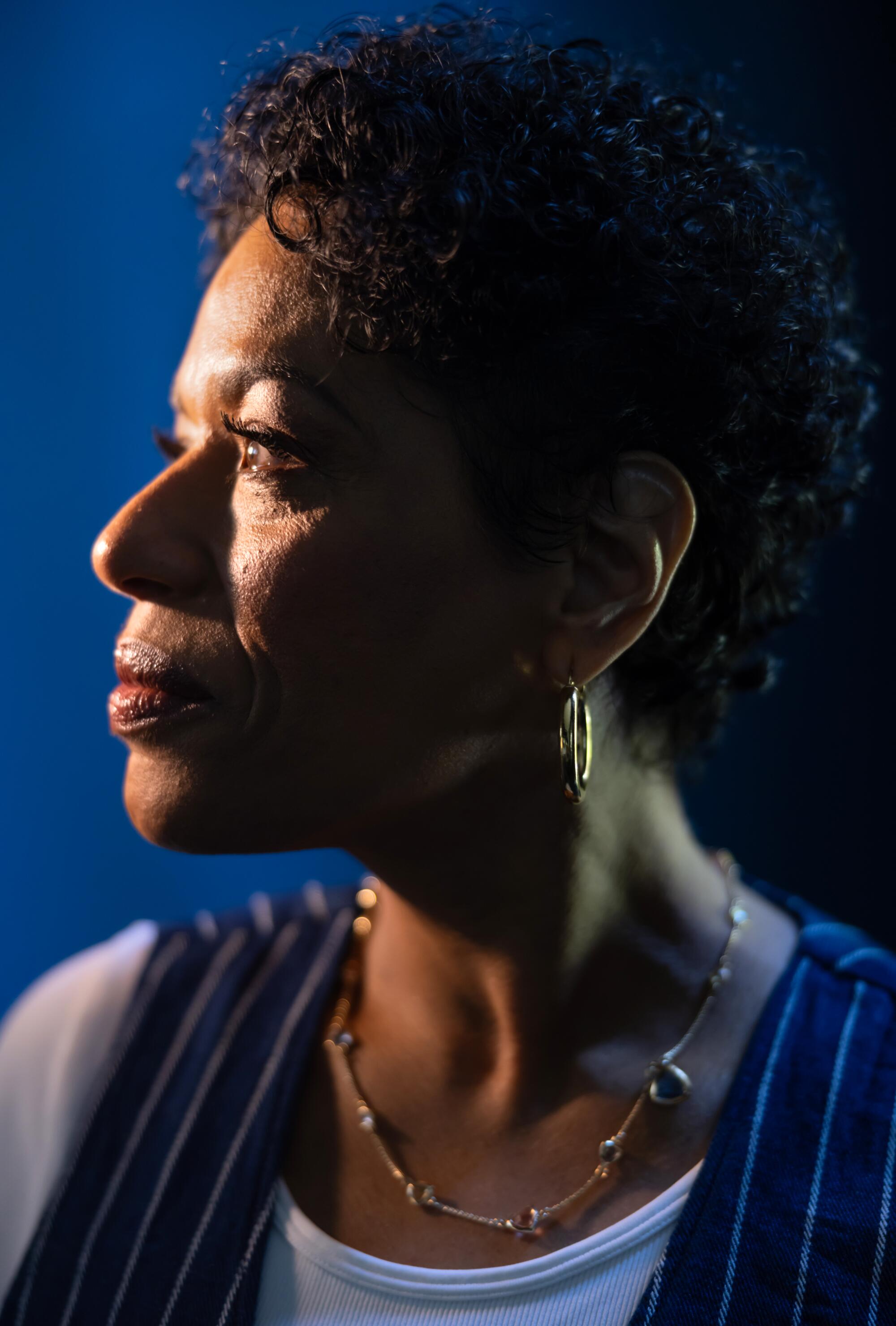Entertainment
Liza Colón-Zayas has put in the work. In 'The Bear,' she makes every second count

There is no nail-biting stress for Liza Colón-Zayas in this restaurant. On a balmy June afternoon, she enters the homey, brightly colored space of Mofongos, a family-run North Hollywood Puerto Rican eatery, and instinctively begins moving her hips to the beat of Ángel Canales’ ”Sabor, los Rumberos Nuevos,” which slaps the eardrums upon entering.
In scheduling our meet-up, she had one request: shining a light on a small business akin to the one featured on “The Bear,” the hit FX series about the people working in the chaotic kitchen of a Chicago sandwich shop turned fine-dining restaurant. It’s less than a week before the third season of the series drops — it’s now streaming on Hulu — and the Nuyorican actress, who plays no-nonsense cook Tina Marrero, has never been to this establishment yet quickly offers guidance on the dishes to the rookie in front of her.
“You like pork?” she begins. “There’s also arroz con gandules, which is yellow rice, with the sofrito and pigeon peas. Mofongo, as the name suggests, are fried plantains mashed together with crispy pork skin and they fill it in the pilon with whatever you want — shrimp, chicken or pork — and a sauce around it.”
At just over 5 feet tall, Colón-Zayas seems smaller seated at this tabletop that’s glossed with a photo of Puerto Rican baseball icon Roberto Clemente. Unlike her character, she isn’t stingy or curt with her words and is more likely to insist you sample her order of mofongo de carne guisada than try to sabotage the cooking of your stock by turning up the flame to high heat. But much like her character, Colón-Zayas knows what it’s like to be in plain sight, putting in the work for years, hoping for the nexus of potential and opportunity.
With a nearly 30-year career, Colón-Zayas is an Off Broadway veteran. She’s performed on a string of television shows and films over the years, often in day-player roles but also in roles that tapped her range. Then came “The Bear,” FX’s critical and audience darling, which has nabbed a slew of awards to back up the hype.
For two seasons, her character has simmered on the back burner — active and essential but not at a full boil just yet. As a new regime takes over at the Original Beef of Chicagoland following the death of its owner, Michael “Mikey” Berzatto (Jon Bernthal), Tina’s guard is up, resistant to the orders being slung at her by new, younger bosses. In time, she relaxes enough to see that change could be for the better — last season, she enrolled in culinary school and was promoted to sous chef.
“I get her,” Colón-Zayas says. “She’s on guard, like, ‘You’re walking into my territory.’ This is not just a job. This is a made family. Restaurants, old-school traditional ones, are shutting down all around us. She doesn’t know what the changes Carmy is trying to make will mean. And we’ve just lost a family member, Mikey.”
In the third season, Tina comes into focus. And so does Colón-Zayas.
Jeremy Allen White as Carmen “Carmy” Berzatto and Liza Colon-Zayas as Tina in “The Bear.”
(Matt Dinerstein / FX)
Episode 6, titled “Napkins,” rewinds back five years before the petite and sharp-tongued working mom was stretching her culinary potential. Already stressed about finances after a rent increase, Tina loses her job managing payroll at a confectionery company. Her husband, played by Colón-Zayas’ real-life spouse, David Zayas (“Dexter”), is a doorman waiting for a promotion that will never come. With bruised pride, financial anxiety and ample copies of her résumé in hand, Tina pounds the pavement each day — smile locked in — seeking work but being met with indifference or outright rejection.
“I am glad to know that she was far more respectable than I thought she’d be,” says Colón-Zayas, who didn’t create a backstory for the character beyond deciding she was a transplant from New York. “When we’re introduced to Tina, she’s pretty hardcore, but we know she’s a mom. I didn’t realize that she had a 9-to-5, and they were working poor, they were stable, and [she and her husband] are in love. There was this whole other peaceful, kind of normal side of her life.”
A pivotal moment in the episode, which was directed by Ayo Edebiri (who plays Sydney Adamu in the series), arrives when Tina, after one particularly disappointing day on the job search, steps foot in the show’s central sandwich shop. The volume gets turned up, both in sound and grace. She orders only a coffee but is given a free Italian beef sandwich by the boisterous but kind staff.
1

2

1. Tina (Liza Colón-Zayas) at the Beef. (FX) 2. Liza Colon-Zayas as Tina with her husband, David Zayas. (FX)
As she finds a table away from the chaos, she’s overcome by the reality of her situation, crying into her food. When Mikey checks on her, it leads to a heartfelt conversation between them — in part, about people who get to live out their dreams and the people who are just trying to survive — that ends with him offering her a job. The scene was shot over two days.
Edebiri says she wanted that moment to feel like viewers were stepping back to Season 1, recalling the noise and frenetic energy, while showcasing Colón-Zayas’ prowess as an actor.
“One of the many amazing things about Liza is she’s so petite, and so you’re about to use this sense of wonder,” Edebiri says. “She does a lot of that with just her face and her openness, but Tina’s coming from also this really arduous journey of rejection — shocking and demoralizing rejection — and then in this really chaotic and unexpected place she finds warmth.”
The scene is also a window into Mikey, whom we’ve seen glimpses of throughout the series, but his connection to the staff and what his loss meant comes further into focus.
“Mikey is such a complicated character; we see so many different facets of him,” Edebiri says. “He’s a tough, damaged guy, but he has a lot of love, and invoked a lot of love in people. I think Tina is such an important person to that story.”

Liza Colón-Zayas says she didn’t create a backstory for Tina, but in Season 3 we learn more. “There was this whole other peaceful, kind of normal side of her life.”
(Christina House / Los Angeles Times)
It gets Colón-Zayas thinking of her own journey to this point in her career.
The youngest of five children, she lived in subsidized housing in the South Bronx with her mother. (Her parents split when she was young, but her father was in her life.) Her gumption revealed itself at an early age. When she was 7, she wrote a letter to the producers of “The Partridge Family” to consider her as a replacement for red-haired, tambourine-playing Tracy Partridge: “I was gonna run away. I was gonna take a taxi, and I was gonna take over because I could play the tambourine much better. Then my brother saw the letter and opened it and read it out loud and made fun of me, and I was mortified. It never got sent.” But she found other ways to hone her craft: impersonating Erica Kane, Susan Lucci’s character on the ABC soap “All My Children,” for guests at her mother’s repeated request.
Talking about her early dreams evokes other emotions. At 16, she joined the Church of Bible Understanding, a controversial religious group. When she was approached by members of the congregation on Fordham Road in the Bronx, her family situation was tough. “They seemed very caring,” she says.
Describing the group as a cult, she said it encouraged isolation from and distrust of nonmembers. She left home at 18 and was taken to Philadelphia, near where the group was founded. There, she took a training course with the church and recruited for it while also working a full-time job at a bakery. The church kept the money she earned and wouldn’t deliver messages or mail from her family.
“I got in deep,” Colón-Zayas says, her eyes turning glassy. “There was no sexual abuse or physical violence to me. And I never witnessed that. It was mind control.”
She eventually returned to New York and, after some vacillating, broke ties with the church. She attended SUNY Albany and her world opened up after she saw a play by Native American women. “I remember thinking, ‘This is what I want to do.’”
She has been a part of the LAByrinth Theater Company since its founding in 1992 and began her acting career off-Broadway, appearing in productions of Quiara Alegría Hudes‘ “Water by the Spoonful” and originating numerous roles in Stephen Adly Guirgis’ works including “In Arabia We’d All Be Kings,” “Our Lady of 121st Street” and “Between Riverside and Crazy.” (She reprised her role in “Between Riverside and Crazy” for a third time in 2022, making her Broadway debut in the process.) She also wrote, produced and starred in “Sistah Supreme,” a semiautobiographical solo show about growing up Latina in New York in the 1970s and ’80s.
“LAByrinth became my artistic community,” says Colón-Zayas, who felt frustrated by both the scarcity of roles for Latinx actors and the stereotypical tones roles often had. “That’s always my advice to young people: Find your artistic community. Find the people who hold you up. It could be just two or three of you, but if they hold you up and you have the same interest and you want to meet in your house and do writing exercises and read scenes or whatever, it helps you stand taller.”
According to Guirgis, a longtime friend who directed “Sistah Supreme,” what makes Colón-Zayas so compelling as a performer is her push for truth and that she draws from a deep well of lived experience.
“She’s always going to give you 100% of her heart, and that is going to end up being something onstage that’s going to be painful, funny, truthful, outrageous but real. Her acting doesn’t seem like acting,” he said.
After years of small roles in shows like “Law & Order,” “Sex and the City” and “Nurse Jackie,” Colón-Zayas got her first recurring role in 2019 on the short-lived OWN drama “David Makes Man.” In 2021, she booked another recurring role in HBO’s revival of “In Treatment.” Then came the role of Tina on “The Bear.”
Her husband commended her perseverance as an actor, maneuvering through disappointment and frustration but eventually finding mainstream visibility.
“The way she dealt with the reality at the time, which was there weren’t many opportunities for someone like Liza, and her struggles with it, yet finding ways to get through it,” Zayas says of his wife. “She’s got a great reputation in theater, she’s done amazing work in theater. So just watching her continuing to move forward is inspiring.”
In her youth, Colón-Zayas got some experience working in restaurants. She worked at a doughnut shop and the counter at a deli, and waited tables at a family-owned Italian restaurant in Albany. “I was always spilling something or getting orders wrong,” she says.
And while she enjoys cooking, she’s modest about her skills. In order to prepare for Season 2 and Tina’s new role as sous-chef, Colón-Zayas did intense training for a week with James Beard Award-winning chef David Waltuck of Chanterelle and with Courtney Storer — the sister of “The Bear” creator Christopher Storer — who is a culinary producer on the show and previously held senior roles at Animal and Jon & Vinny’s in Los Angeles.
“I learned all of the basics, even how to properly hold the knife,” Colón-Zayas says. “I had no idea how sharp those knives were. Day 1, I must have had maybe four or five bandages on my finger because the blades are so sharp you don’t feel it. I’m no pro at home, but I’m better.”

“She’s always going to give you 100% of her heart,” says playwright Stephen Adly Guirgis, who has worked closely with Liza Colón-Zayas over the years.
(Christina House / Los Angeles Times)
It’s quite the turn for the actress who said she once failed to return a copy of a James Beard cookbook when she was a teenager. Not that she ever dared to make a recipe from it: “I had intentions, but it’s a lot of scary ingredients for a poor kid.”
For what it’s worth, Guirgis says Colón-Zayas makes the best roast chicken, which he describes as “out of this world, juicy and absolute perfection.” Asked about her technique, she says her trick is marinating it for a few hours in white vinegar, a ton of garlic, oregano and pepper. “When you put it in to roast, soak a paper towel in oil, so that when you cover it with the foil, it will not rip the skin. And brush the top skin with a little more seasoning and oil so it crisps up real cute, to the point where, when you take it out, it should be falling off the bone.”
Knowing the ins and outs of cooking is one thing. Navigating how surreal it feels to be on one of TV’s buzziest shows is something Colón-Zayas is still getting used to.
“I realize, in hindsight, there are things the universe protected me from myself because I wasn’t ready then,” she says. “It’s hard to take in the good things when you’re always used to scarcity, when your friends and loved ones are struggling. I don’t want to be perceived as being insensitive to that. To have this episode, that is Ayo’s directorial debut, and it’s all me, I cried every time I read the script. It validated that I had a gift.”
Determined not to let the tears welling in her eyes cascade down, she pivots.
“Anyway,” she says, as she moves the food on her plate around as the restaurant’s lively soundtrack overwhelms the moment. By the time we make our way out, she’s let the rhythm find her again.

Movie Reviews
Movie Review: Jodie Foster shines as a psychoanalyst on the edge in ‘A Private Life’
Jodie Foster plays a self-assured psychoanalyst whose composure unravels after a patient unexpectedly dies in the genre-bending French film “A Private Life.”
Rebecca Zlotowski’s latest, in theaters Friday, is part noir, part comedy of remarriage, and part Freudian fever dream about past lives.
This is a film that does not abide by rules or play into any easy expectations about what it should be, resulting in big swings, tonal shifts and even a lurking Holocaust through-line. Also, oddly enough considering such grave themes and subjects, it’s all done with a relatively light touch set, in part, by the cheeky needle drop at its opening: the Talking Heads song “Psycho Killer.” Some parts work better than others, but you can’t help but admire the go-for-broke originality and unabashed femininity of it all. And anchoring it all is Foster, using the full force of her star power and impeccable French to make “A Private Life,” unwieldy and complex as it is, go down as easy as a glass of gamay.
Foster’s character, Dr. Lilian Steiner, is an American expat living and working in France. She’s an accomplished, sophisticated woman who believes she has a grasp on people and the world around her, recording and cataloging all her private sessions with clients on meticulously organized CDs. This act in and of itself is a little odd — her son wonders why she doesn’t just use a more modern method, for instance. But it also kind of gets to the heart of why, perhaps, despite her evident intelligence, there’s a cold disconnect between analyst and subject. Is she even listening to them?
Lilian starts to wonder this herself after she receives a call that her client Paula ( Virginie Efira ) has died by suicide. Paula was not someone she believed was capable of this. Instead of looking inward, she goes back to the tapes to begin an amateur investigation to find some other explanation: It must be murder, she concludes. Suspects include Paula’s daughter Valérie (Luàna Bajrami) and husband Simon (Mathieu Amalric).
She also enlists a sidekick in her sleuthing, her ex-husband Gabriel (a delightful Daniel Auteuil ) who is more than happy to go along for the ride, to listen to her conspiracy theories over several bottles of wine, to be a decoy distraction so that she can snoop through Simon’s house, and, ultimately, to just be there for her, no matter how unhinged she’s becoming. You can just see the love and admiration in his attentiveness. He’s not off put by the crazy; it’s just part of what makes her, well, her. Their rekindled relationship, so effortlessly lived in, so mature, so fun, is by far the highlight of “A Private Life.”
It’s a shame that their romance is basically a side show to the more convoluted rest, which involves a hypnotist and a revelation of a past life in which Lilian and Paula were members of the same WWII-era orchestra and lovers torn apart by jealous exes and Nazis. One of those Nazis is Lilian’s son (Vincent Lacoste), which she awkwardly, drunkenly tells him at his birthday dinner to try to explain why they’ve never been that close. She’s also completely disinterested in her grandchild, which might be one “let’s unpack that” too many in this film. In other words, there’s a lot going on in “A Private Life,” which Zlotowski co-wrote with Anne Berest.
This image released by Sony Pictures Classics shows Jodie Foster, left, and Virginie Efira in a scene from “A Private Life.” Credit: AP/Jérôme Prébois
One thing there’s not enough of is Efira. She gets some moments in flashback, but most of them teeter on the “dead wife montage” cliche. It’s not that Zlotowski wasn’t aware of what she had in Efira (case in point, their poignant, tender work together in “Other People’s Children”), but perhaps she was counting on our familiarity to fill in the gaps.
“A Private Life” is ultimately Foster’s show anyway and she seems to relish the tricky assignment. The tone around her might be on the lighter side, but for Lilian, the stakes are grave with the very essence of her self-worth and life’s work on the line. It’s a fascinating portrait of a woman essentially forced to rethink and revise all of the rules she’d lived by, the facts that she made sense of the world with and submit herself to the idea that some things might just be unknowable — even for a know-it-all psychoanalyst.
“A Private Life,” a Sony Pictures Classics release in theaters Friday, is rated R by the Motion Picture Association for “language, graphic nudity, brief violence, some sexual content.” Running time: 105 minutes. Three stars out of four.
Entertainment
Zoe Saldaña becomes the highest-grossing actor of all time

After another impressively profitable weekend in theaters, James Cameron’s “Avatar: Fire and Ash” helped crown its star Zoe Saldaña the queen of the box office.
The third “Avatar” movie boasted $21.3 million in North American sales last week, bringing it to a global total of $1.23 billion. With those impressive stats, Saldaña officially surpassed Scarlett Johansson as the highest-grossing actor of all time.
The Oscar winner has grossed more than $15.47 billion at the international box office, according to box office tracking website the Numbers. Johansson only recently gained the title after surpassing her “Avengers” co-star Samuel L. Jackson with the release of last summer’s “Jurassic World Rebirth.”
What helped buoy Saldaña to the top is the fact that the 47-year-old actor stars in the three highest-grossing films of all time: 2009’s “Avatar” ($2.9 billion), 2019’s “Avengers: Endgame” ($2.8 billion) and 2022’s “Avatar: The Way of Water” ($2.3 billion).
Saldaña is also the only actor to appear in four movies that brought in over $2 billion worldwide. (2018’s “Avengers: Infinity War” grossed $2.05 billion.)
Last year proved that Saldaña’s talent exceeded the realm of popcorn movies when she nabbed her first Academy Award for her supporting role in the controversial musical “Emilia Pérez.” Her win marked the first time an actor with Dominican roots had won an Oscar.
“I am a proud child of immigrant parents, with dreams and dignity and hardworking hands,” she said through tears while accepting the award for supporting actress. “And I am the first American of Dominican origin to accept an Academy Award, and I know I will not be the last.”
Saldaña cemented her Oscar win while side-stepping criticisms of the film — namely regarding its portrayals of Mexicans and transgender people — as well as the scandal that surrounded “Emilia Pérez” co-star Karla Sofía Gascón, when her offensive tweets with anti-Muslim, anti-diversity and racist language resurfaced.
Movie Reviews
Vaa Vaathiyaar Movie Review: A fond, funky & fun throwback to old-school masala films

Vaa Vaathiyaar Movie Synopsis: Even as he keeps up an appearance of following in the footsteps MGR in front of his grandfather, a die-hard fan of the legend, Ramu is actually a corrupt cop, who’s helping in a mission to nab activists exposing the government. What happens when an incident triggers the Vaathiyaar in him? Vaa Vaathiyaar Movie Review: In his interviews about the film, director Nalan Kumarasamy repeatedly stressed on the fact that he planned Vaa Vaathiyaar as an attempt at recreating the old-school masala film in his own style. And that’s exactly what he delivers with his film. The simplicity of the MGR film formula meets the new-age-y plot device of Maaveeran in this fond, fun, funky throwback to the masala films of an earlier era. The film does take a while to get going with the beats of the initial set-up coming across as little too familiar. The narrative rhythm, too, is slightly off, with far too many songs popping up at frequent intervals. Though, it helps that Santhosh Narayanan’s songs are short and groovy. And the composer delivers a score that superbly elevates the emotional moments. But once we get into the main conflict, things perk up. An anonymous group of hacker-activists exposes a shootout plot by power broker Periasamy (Sathyaraj) and the chief minister (Nizhalgal Ravi) at a Sterlite-like protest. The government decides to nab them before they can cause further damage to a 142 million euro business deal. How does Ramu – a corrupt cop, who is keeping up a facade of being a do-gooder for the sake of his grandfather (Rajkiran, who has become the default casting choice for such well-meaning boomer roles), a die-hard MGR fan – gets involved in this and where does the OG Vaathiyaar figures in this scheme of things?Vaa Vaathiyaar shows that in this age of hyper-masculine action – and even romantic – films, it’s still possible to make a rousing commercial entertainer with a star without relying on guns and gratuitous bloodshed. The film’s action set-pieces have the hero taking on dozens of henchmen (and cops, too!), but it’s all done in swashbuckling MGR style. And in Karthi, it has an actor who is brave enough to take on a risky role, given the stature in which MGR is held by the Tamil people. Rather than merely mimicking him, which would have ended up as a spoof, the actor wonderfully captures the spirit of the legend’s onscreen image and creates moments that are genuinely heartfelt. Credit should also go to Nalan for finding the right pitch at which the actor should play these portions. While there are quite a few throwbacks to iconic MGR scenes, the filmmaker even succeeds in his modern take on the iconic song, Raajavin Paarvai Raaniyin Pakkam.The film would have been even better with a stronger villain. The film initially builds up Periyasamy to be ruthless and powerful, and with someone of Sathyaraj’s calibre playing this role, we expect more only to be deceived in the end. There’s also some build up to Nivas, a rival cop, who’s keen on nailing Ramu, but this arc, which could have added tension, is left incomplete after a while.That said, Nalan’s bold move to call back to MGR’s real-life hospitalisation and resurgence in the climax leaves the film on an emotional high.
-

 Montana4 days ago
Montana4 days agoService door of Crans-Montana bar where 40 died in fire was locked from inside, owner says
-

 Technology1 week ago
Technology1 week agoPower bank feature creep is out of control
-

 Delaware5 days ago
Delaware5 days agoMERR responds to dead humpback whale washed up near Bethany Beach
-

 Dallas, TX6 days ago
Dallas, TX6 days agoAnti-ICE protest outside Dallas City Hall follows deadly shooting in Minneapolis
-

 Dallas, TX1 week ago
Dallas, TX1 week agoDefensive coordinator candidates who could improve Cowboys’ brutal secondary in 2026
-

 Virginia4 days ago
Virginia4 days agoVirginia Tech gains commitment from ACC transfer QB
-

 Education1 week ago
Education1 week agoVideo: This Organizer Reclaims Counter Space
-

 Iowa1 week ago
Iowa1 week agoPat McAfee praises Audi Crooks, plays hype song for Iowa State star



















